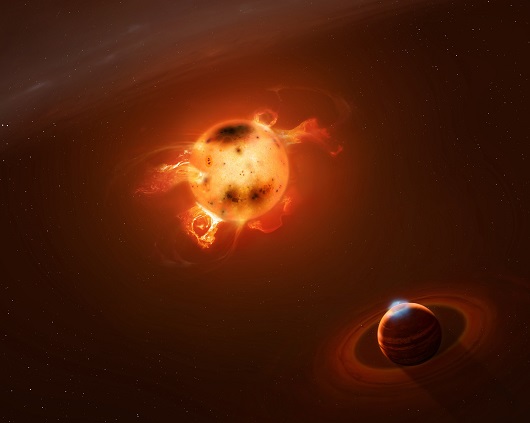Newborn planet solves 20 year puzzle

The discovery of a two million year old giant ‘newborn’ planet has solved a twenty year old planetary puzzle.
The find – published this week by the journal Nature– is a major step forward in science’s understanding of how planetary systems form and evolve.
The discovery of the ‘hot Jupiter’ was made by an international team – including the University of St Andrews in the UK – using three telescopes and two completely different methods of analysis.
The finding was made as the team monitored a 2 million-year-old infant star, V830 Tau, in the Taurus stellar nursery, some 430 light-years away.
Using telescopes atop Pic du Midi in the French Pyrénées south of Toulouse and on the dormant Mauna Kea volcano in Hawaii, they noticed a regular 4.9-day “wobble” in the velocity of the host star. The ‘wobble’ signals the presence of a giant planet almost as massive as Jupiter, orbiting its host star, an infant sun.
Professor Andrew Collier Cameron, of the School of Physics & Astronomy at the University of St Andrews, was a co-author of the study, and the only researcher from the UK to participate in the discovery. He said: “Detecting a hot Jupiter orbiting such a young star is really tough, because the dark magnetic spots on the star’s surface make the star appear to wobble as it spins.
“We had to use two entirely different data analysis methods to be certain that we were seeing the orbital signature of a planet against the star’s own magnetic signals.”
At 2 million years old, the newly-discovered planet is the stellar equivalent of a week-old human baby.
Since they were first discovered two decades ago, astronomers have puzzled over how hot Jupiters can settle into orbits 100 times closer to their host stars than our own Jupiter is to the Sun.
The discovery that a newborn hot Jupiter could be present at such an early age helps to answer this question.
The study was led by Dr Jean-François Donati of The Research Institute in Astrophysics/Observatoire Midi-Pyrénées and also involved researchers from Brazil, Taiwan and Canada.
Dr Jean-François Donati explained: “Our discovery demonstrates for the first time that such bodies can be generated at very early stages of planetary formation, and likely play a central role in shaping the overall architecture of planetary systems.”
Co-author Clément Baruteau, an astronomer at the Observatoire Midi-Pyrénées, added: “Planet formation models offer two competing explanations of how and when this migration of hot Jupiters occurred. Either it happened early while these planets were still forming, or much later, with some planets being kicked closer to their stars due to the interaction of multiple planets, or both.
“Our discovery demonstrates that the first, earlier option is taking place; it revives the long-running debate about how and when this migration occurs, and brings us one step forward in our understanding of how planetary systems form.”
The researchers say that the next generation of telescopes being built in 2017 and 2019 will allow vastly superior planet-detection capabilities, allowing them to further explore the formation of new worlds.
Note to news editors:
Professor Andrew Collier Cameron (University of St Andrews) is available for interview on: 01334 463 147, 07834 535 340 or email [email protected].
Lead author Dr Jean-François Donati (The Research Institute in Astrophysics and Planetology [IRAP] and OMP Observatoire Midi-Pyrénées) is also available on: +33 561 332 917 or email [email protected].
Note to picture editors:
Image: Artist view of a newborn giant planet like the one newly discovered in the immediate vicinity of the very active infant star V830 Tau, as seen by an observer located close to the giant planet.
Image credit: Mark A Garlick/markgarlick.com
Young stars are extremely active, featuring at their surfaces spots and magnetic fields orders of magnitude larger and stronger than those of the Sun. This activity generates in the light of young stars perturbations that are much larger than the reflex motion that orbiting planets induce — making such planets, even close-in giants, quite tricky to detect.
To be able to recover planet signals, astronomers need to accurately model spot distribution and large-scale magnetic fields of young stars using tomographic techniques inspired from medical imaging.
The new telescopes will be built by SPIRou and SPIP.
Issued by the Press Office, University of St Andrews, contactable on 01334 462530 or email [email protected].
Category Research